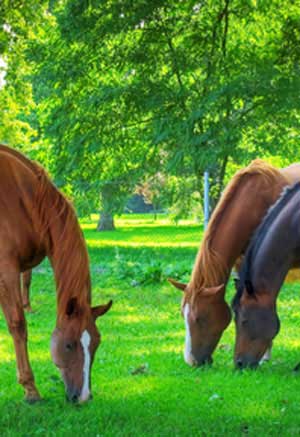Wage War On Equine Parasites

Written by Preston Hickman, DVM, Wichita Equine and Sports Medicine
- Remove and dispose of manure droppings in the pasture at least twice weekly.
- Mow pastures regularly to expose parasite eggs and larvae to the elements. If harrowing is employed it should only be done on pastures not currently being grazed. Allow those pastures harrowed to rest for at least 60 days prior to being used again; this allows larvae counts to fall.
- Rotate pastures to allow grass to rest and decrease egg counts. If possible utilize a cross-grazing program allowing other livestock, such as sheep or cattle, to graze pastures. This will interrupt the life cycles of parasites for both species.
- Group horses by age to reduce exposure to certain parasites and maximize the deworming program. Reducing exposure is critical to proper growth and development of young animals.
- Keep the number of horses per acre to a minimum to prevent overgrazing and reduce the fecal egg counts. Stocking rate ideally should never be more than one animal per two acres.
- Use a feeder for hay and grain rather than feeding on the ground. This will do two things: it will keep the grass from being overgrazed in that area and decrease the number of infective larvae consumed.
- Remove Bot eggs quickly from the horse’s hair coat to prevent ingestion; it is the only parasite that does not require grazing by the host prior to being infective.
- Rotate deworming agents, not just brand names, to prevent chemical resistance.
- Consult your veterinarian to set up an effective and regular deworming program.
Proper pasture management is the most effective way to control parasite contamination, but with many safe and convenient products available today, establishing an effective deworming program is easy. A good parasite control program will go a long way toward maximizing your horse’s appearance, performance and comfort. The net result will be an animal that is as healthy on the inside as it appears on the outside. Discuss a plan with your veterinarian and implement it without delay.
About the author:
Dr. Preston Hickman practices veterinary medicine in Wichita, Kansas, specializing in equine podiatry and sports medicine. He combines traditional veterinary medicine with video gait analysis to diagnose physical problems and abnormal motion in horses. His experience as a farrier and chiropractor allow him unique perspective into biomechanical movement. Dr. Hickman has worked extensively with horse wellness issues as Assistant Medical Director for the Louisiana Racing Commission, overseeing four tracks and 16 veterinarians. Dr. Hickman has a background in mixed practice, equine and bovine veterinary medicine, as well as veterinary consultation to feedlots.


